Carousel
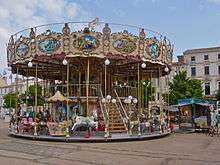
A carousel (American English: from French carrousel and Italian carosello), roundabout (British English),[1] or merry-go-round, is an amusement ride consisting of a rotating circular platform with seats for riders. The "seats" are traditionally in the form of rows of wooden horses or other animals mounted on posts, many of which are moved up and down by gearwork to simulate galloping, to the accompaniment of looped circus music. This leads to one of the alternative names in American English, the galloper. Other popular names are jumper, horseabout and flying horses.
Carousels are commonly populated with horses, each horse weighing roughly 100 lbs (45 kg), but may include diverse varieties of mounts,[2] like pigs, zebras, tigers, or mythological creatures such as dragons or unicorns. Sometimes, chairlike or benchlike seats are used as well, and occasionally mounts can be shaped like airplanes or cars.
In a playground, a roundabout or merry-go-round is usually a simple, child-powered rotating platform with bars or handles to which children can cling while riding.
History
Early carousels

The modern carousel emerged from early jousting traditions in Europe and the Middle East. Knights would gallop in a circle while tossing balls from one to another; an activity that required great skill and horsemanship. This game was introduced to Europe at the time of the Crusades from earlier Byzantine and Arab traditions. The word carousel originated from the Italian garosello and Spanish carosella ("little battle", used by crusaders to describe a combat preparation exercise and game played by Turkish and Arabian horsemen in the 12th century).[3] This early device was essentially a cavalry training mechanism; it prepared and strengthened the riders for actual combat as they wielded their swords at the mock enemies.
By the 17th century, the balls had been dispensed with, and instead the riders had to spear small rings that were hanging from poles overhead and rip them off. Cavalry spectacles that replaced medieval jousting, such as the ring-tilt, were popular in Italy and France. The game began to be played by commoners, and carousels soon sprung up at fairgrounds across Europe. At the Place du Carrousel in Paris, an early make believe carousel was set up with wooden horses for the children.[4]
By the early 18th century carousels were being built and operated at various fairs and gatherings in central Europe and England. Animals and mechanisms would be crafted during the winter months and the family and workers would go touring in their wagon train through the region, operating their large menagerie carousel at various venues. Makers included Heyn in Germany and Bayol in France. These early carousels had no platforms; the animals would hang from chains and fly out from the centrifugal force of the spinning mechanism. They were often powered by animals walking in a circle or people pulling a rope or cranking.
Direction of rotation
In the United Kingdom, merry-go-rounds usually turn clockwise, while in North America and Mainland Europe, carousels typically go counterclockwise (anticlockwise) as viewed from above.[5]
Modern carousels
By the mid-19th century the platform carousel was developed; the animals and chariots were fixed to a circular floor that would suspend from a centre pole and rotate around. These carousels were called dobbies and were operated manually by the operator or by ponies.
In mid-19th century England, the carousel became a popular fixture at fairs. The first steam-powered mechanical roundabout, invented by Thomas Bradshaw, appeared at the Aylsham Fair in about 1861. It was described by a Halifax Courier journalist as:
- a roundabout of huge proportions, driven by a steam engine which whirled around with such impetuousity, that the wonder is the daring riders are not shot off like cannon- ball, and driven half into the middle of next month.[6]
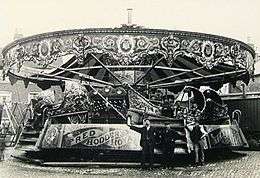
Soon afterwards, the engineer Frederick Savage began to branch out of agricultural machinery production into the construction of fairground machines, swiftly becoming the chief innovator in the field. By 1870, he was manufacturing carousels with Velocipedes (an early type of bicycle) and he soon began experimenting with other possibilities, including a roundabout with boats that would pitch and roll on cranks with a circular motion, a ride he called 'Sea-on-Land'.[7]
He soon applied a similar innovation to the more traditional mount of the horse; he installed gears and offset cranks on the platform carousels, thus giving the animals their well-known up-and-down motion as they travelled around the centre pole. The platform served as a position guide for the bottom of the pole and as a place for people to walk or other stationary animals or chariots to be placed. He called this ride the 'Platform Gallopers' . He also developed the 'platform-slide' which allowed the mounts to swing out concentrically as the carousel built up speed. Fairground organs (band organs) were often present (if not built in) when these machines operated. Eventually electric motors were installed and electric lights added, giving the carousel its classic look.
These mechanical innovations came at a crucial time, when increased prosperity meant that more people had time for leisure and spare money to spend on entertainment. It was in this historical context that the modern fairground ride was born,[8] with Savage supplying this new market demand. In his 1902 Catalogue for Roundabouts he claimed to have
- ...patented and placed upon the market all the principal novelties that have delighted the many thousands of pleasure seekers at home and abroad.[9]
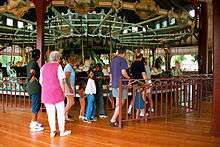
In the United States, the carousel industry was developed by immigrants, notably Gustav Dentzel of Germany and Dare from England, from the late 19th century. Several centers and styles for the construction of carousels emerged in the United States: Coney Island style – characterized by elaborate, and sometimes faux-jeweled, saddles[10] – with Charles I. D. Looff; Philadelphia style – known for more realistically painted saddles – with Dentzel and the Philadelphia Toboggan Company; and Country Fair style – often with no saddles at all – with Allan Herschell and Edward Spillman of western New York, and Charles W. Parker of Kansas. The golden age of the carousel in America was the early 20th century, with large machines and elaborate animals, chariots, and decorations being built.
Similar uses of the term "carousel"
On some playgrounds, small manually powered carousels exist.
At airports, rotating conveyors in the baggage claim area are often called luggage carousels.[11]
Various photographic slide projectors, notably those made by Kodak until 2004, used rotating trays or magazines called carousels to hold the slides and were often known as "carousel projectors."
Notable carousels
- Carters Steam Fair has a set of travelling Steam Gallopers that were originally built by Robert Tidman & Sons of Norwich in 1895 and run on steam to this day.[12]
- The first carousel (and amusement ride) at Coney Island, NY was hand-carved and built by Charles I. D. Looff in 1875 and installed at Mrs. Lucy Vanderveer's Bathing Pavilion in 1876.
- The Nunley's Carousel that once operated at Nunley's Amusement Park, Baldwin, N.Y. was built in 1912 by the Stein and Goldstein Artistic Carousell Co. When the park closed in 1995, the carousel was purchased by Nassau County and placed in storage. It was fully restored and opened in 2009 at the Cradle of Aviation Museum in Garden City, N.Y.[13]
- The carousel at Phantasialand in Germany is one of the biggest in the world, made by Preston & Barbieri one historical amusement ride factory in Italy.[14]
- The Small Fry Carousel in Boynton opened in 2001 to replace the classic carousel with the eagle shields. In 2013, the carousel was closed and replaced with bungee jumping.
- The world's only two-row stationary carousel built from an original Dentzel blueprint left in existence,[15] the Highland Park Dentzel Carousel and Shelter Building, is located in Highland Park in Meridian, Mississippi.
- In May 2005, William Henry Dentzel III, built the world's first solar-powered carousel. The carousel operates during Solfest at the Solar Living Institute in Hopland, California.[16][17]
- The Crescent Park Looff Carousel in Riverside, Rhode Island was built in 1895 and still operates in its original location. The 61 horses, one camel, and four chariots have been restored and the ride renovated. Charles I. D. Looff used this carousel as a showpiece for prospective customers. This is one of the few carousels that feature a ring-arm with steel rings and a brass ring. The original A. Ruth & Sohn organ still plays music for the patrons.
- There is only one carousel in the world that rides in a waving motion - "Over the Jumps: The Arkansas Carousel" in Little Rock, Arkansas. It is also the only remaining wooden track carousel built by the Herschell & Spillman Company, and one of only four track carousels still in existence.
- The carousel at Conneaut Lake Park in Conneaut Lake, Pennsylvania is the last T.M. Harton Carousel that is still in operation and its Artizan band organ is one of two known of the same model in the world.
- The carousel at the Heritage Museums and Gardens in Sandwich, MA was built in 1908 by Charles Looff and is electrically powered.
- In 2006, SeaWorld Orlando opened Sea Carousel, Florida's first aquatic carousel.
- The carousel at Heritage State Park in Holyoke, MA was built in 1929 by the Philadelphia Toboggan Coasters company and assembled at the now shuttered Mountain Park. The carousel was reassembled and preserved (in full operation) at Heritage State Park with the help of John Hickey and the Holyoke Water Power Company in 1993.
- The Flying Horses Carousel currently in Oak Bluffs, Massachusetts is the nation’s oldest platform carousel and has been designated by the U.S. Department of the Interior as a national landmark. Constructed in 1876 by Charles Dare, it is one of only two Dare carousels still in existence. Originally operated at a Coney Island, NY amusement park, it was moved to Oak Bluffs in 1884, where it has lived in its red barn, delighting generations of Island residents and visitors ever since. The carousel was acquired by the Martha's Vineyard Preservation Trust in 1986 to prevent it from being dismantled and sold piecemeal to collectors of antique carved horses.
- The Flying Horse Carousel, located in Watch Hill, Westerly, Rhode Island, was built in 1876 and is listed as a National Historic Landmark. It is one of two Charles Dare carousels in existence, the other being the Flying Horses Carousel in Oak Bluffs, Massachusetts. It is considered the oldest of its type "in which the horses are suspended from a center frame," as opposed to being mounted on a wooden platform, which causes the horses to "fly" as the carousel gains speed.[18]
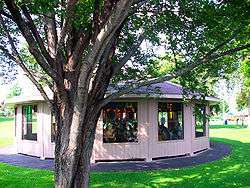
- Binghamton, New York is considered the "Carousel Capital of the World" for the six original carousels in the Triple Cities area, donated by George F. Johnson, owner of the Endicott-Johnson Company early in the 20th century. These Carousels, manufactured by the Allen Hershell Company in the "country fair" style, were donated with the express stipulation that they would never charge admission for anyone to ride them. Apparently when Mr. Johnson was a child he was frequently too poor to ride the local carousel and he vowed this would never happen to another child in the area. The carousel at the Ross park zoo in Binghamton, NY does charge admission, in a way, as it requires the child to drop one piece of litter found in the park into a trash barrel in order to ride. This is all written on a plaque at the entrance to the carousel.{Greater Binghamton New York Convention and Visitors Bureau, visitbinghamton.org, March 2014}
- The oldest existing carousel made in 1779 to 1780 stands in Germany at the Wilhelmsbad Park in Hanau.[19]
- The carousel in Riverfront Park in Spokane, Washington is an original Looff carousel built in 1909 and installed at the Natatorium Park in Spokane.[20]
- The Richland Carrousel Park in Mansfield, Ohio is an indoor carousel in the downtown Historic Carrousel District that was completed in 1991. It is the first hand-carved indoor wooden carousel to be built and operated in the United States since the early 1930s.[21]
- Sydney's Darling Harbour Carousel is a New South Wales Heritage listed attraction. It is an example of an old Edwardian Carousel which are very rare nowadays. It is operated by a classic steam engine which has been retained. The Carousel dates back to the 'Golden Age' of Carousels between the 1890s to the 1920s.

- The Grand Carousel at Kennywood Park was built by William H. Dentzel in 1926 and is a National Historic Landmark. The music on this carousel is provided by a 1916 Wurlitzer Style #153 Military Band Organ and over 1500 lights decorate this ride. The carousel features 50 jumping and 14 stationary horses, a magnificent lion and tiger, and Dentzel's signature Jesters and Cherubs.[22]
- Cafesjian's Carousel was a mainstay at the Minnesota State Fair from 1914 to 1988 when it was saved from the auction block by a non-profit group organized to save the landmark. The carousel is now located in Como Park in Saint Paul, Minnesota.[23]
- The Herschell Carrousel Factory Museum in North Tonawanda, NY has two working carousels: The largest is a 1916 model that is 40 feet (12.2 m) in diameter, with 36 hand-carved horses and over 580 lights. The second is a small aluminum carousel specifically designed for children.[24] The museum is located in the building complex which housed the Allan Herschell Company and is the only museum in the world housed inside an authentic carousel factory.[24]
- The two double-decker Columbia Carousels built by Chance Rides and located at Six Flags Great America and California's Great America are the two tallest carousels in the world.[25]
- The Merry-Go-Round located at Tilden Park in Berkeley, California was built in 1911 by the Herschel-Spillman Company and is one of the few carousels from its day still in operation. In 1976 it was listed on the National Register of Historic Places.[26][27]
- The King Arthur Carrousel has existed since 1932 and was moved to Disneyland in 1954. It is an assembly of two carousels. Walt Disney wanted it to have four courses of all jumpers. The remaining chariot woodwork was repurposed as the "Calliope" tenders of Casey Jr. Circus Train powered gravity coaster.[28]
- Melbourne Zoo's Carousel was built in 1878 in England and imported to Australia in the 1880s by John Briggs an ancestor of Dorrie Freeman. The Carousel travelled the show circuit until 1963 before it finally arrived at Melbourne Zoo.
- Buttonwood Park's carousel was built in 2012 in the United States and is manufactured by Chance Rides and is 28 foot with two rows and is the Americana scenery pack version and has animals and horses together on all the rows. The outer row features animals from the world including America and so many other cities and states.
- Palm Beach International Equestrian Center's carousel was built and added in 2013 with three rows, a rocking chariot and horses excpet there is a missing rocking horse and is manufactured by Bertazzon. This is the first carousel in Palm Beach County until the opening of the Wildlife Carousel at Palm Beach Zoo that is manufactured by Chance Rides and the "Carousels USA" dragon scenery carousel at Lion Country Safari's Safari World portion.
- The Forest Park Carousel, located in the Woodhaven section of the New York City borough of Queens, was built by Daniel C. Muller and one of only two surviving Muller brothers carousels.[29] It was listed on the National Register of Historic Places in 2004.[30]
- The Santa Monica Looff Hippodrome located on the Santa Monica Pier in Santa Monica, California.
- The Merry-Go-Round at Bear Mountain State Park features hand-painted scenes of the Park and 42 hand-carved seats of native animals including black bear, wild turkey, deer, raccoon, skunk, Canada goose, fox, swan, bobcat, rabbit, and more.[31]
- Port Dalhousie, Ontario, Canada, at historic Lakeside Park, is home to an antique carousel which was carved by Charles I. D. Looff in 1905 and brought to St. Catharines in 1921. It continues to provide amusement for young and old alike, at just 5 cents a ride.[32]
- The Carousel at Harper Motors is an iconic landmark on the North Coast of California. Brought to the dealership in 1991, this 1947 Allan Herschell has all original half and half horses except for two metal ones. It is open daily free of charge to the public from 12-4 except on holidays and when inclimate weather doesn't allow for riders.[33][34]
- The historic Santa Cruz Beach Boardwalk Looff Carousel, from 1911, is one of the few carousels still in its original location for more than 100 years. It is a "pure carousel" meaning all of the horses were provided by the same company that built the carousel. It is also one of the few with the rare combination of a working ring dispenser and outside row jumping horses. The carousel features three band organs including a rare Ruth & Sohn 96-key organ with 342 pipes. The Looff carousel was designated a national historic landmark in 1987.[35]
- Ice floe carousels have been constructed on frozen lakes.[36]
Media references
- In Mary Poppins, Mary, Bert, and the children ride a merry-go-round, then leave the carousel on their horses to go off on a fox hunt and a horse race.
- In the film Charade, near the end, there is a scene where appears a carousel in the background with the music of the main theme, a parisian waltz composed by Henry Mancini (Charade carousel) played with bells.
- In Something Wicked This Way Comes by Ray Bradbury, the carnival's carousel can cause riders to become younger or older depending on the direction, left and right in which they ride.
- Carousel (1945) was a Broadway musical featuring hit songs such as "If I Loved You" and "You'll Never Walk Alone". The protagonist, Billy Bigelow, is a carousel barker.
- In the dramatic climax scene of Alfred Hitchcock's Strangers on a Train (1951) the hero and the villain struggle on a carousel.
- David Carradine's 1983 film Americana revolves around a Vietnam veteran's obsession with the restoration of an abandoned carousel.
- In the Australian children's picture book The Carousel by Ursula Dubosarsky, illustrated by Walter di Qual, after an exhilarating ride on a carousel, a child has a semi-mystical vision of the carousel horses breaking free from the wheel and galloping across the world.[37]
- The 1930s novelty song, The Merry-Go-Round Broke Down, is the theme song for the Looney Tunes series of cartoons by Warner Bros.
- The classic children's television programme The Magic Roundabout uses a carousel as its central motif.
- The 1990s children's TV show Playdays had a carousel called Rosie as the central motif for Wednesday episodes from 1992 to 1997, presented and maintained by Mr. Jolly.
The classic film The Sting features a large indoor carrousel adjacent a brothel, where the Madam allows the girls to ride on slow nights.
Gallery
-

Light traces of a carousel, Viktorkirmes in Dülmenn, Germany
-

Modern carousel in Brussels
-

James Noyce & Sons' traditional "gallopers" at Nottingham Goose Fair in 1983
-

A 1920s C.W. Parker merry-go-round in Tucson, Arizona
-

Town Square Carrousel at Adventureland in Altoona, Iowa (Chance-Morgan). Also has a decorative crown for a top.
-

Mangels-Illions Carousel, after its 2000 restoration, on the grounds of the Columbus Zoo and Aquarium in Columbus, Ohio
-

Richland Carrousel Park in downtown Mansfield, Ohio is the first hand-carved indoor wooden carousel to be built and operated in the United States since the early 1930s
-
A traditional Merry-go-round in Covent Garden, London, August 2007
-
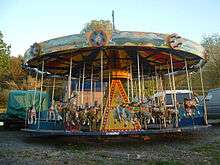
William F. Mangels Kiddie Galloping Horse Carrousel, c. 1935
-
Kennywood's Merry-Go-Round built by William H. Dentzel in 1926 for the World's Fair
-
Carousel at Nickelodeon Universe/Camp Snoopy at the Mall of America in Bloomington, Minnesota
-
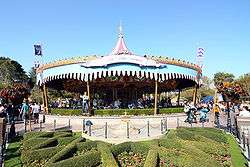
King Arthur Carrousel Fantasyland, Disneyland, Anaheim, California (new version)
-
Forest Park Carousel all closed for the season, November 2009
-

A small hand-driven carousel in Portosín, Porto do Son
-
Central Park Carousel at Central Park in New York City
-

Former Venetian Carousel at Garden State Plaza in Paramus, New Jersey, which closed in 2016
-

Former Philadelphia Toboggan Company Carousel Number 15 at the Palisades Center in West Nyack, New York before it was removed and replaced by a Venetian Carousel in 2009
See also
- Herschell Carrousel Factory Museum
- Carousel of Progress — a novel theater that revolves a seated audience around central stages
- C. W. Parker Carousel
- Chair-O-Planes, aka a swing carousel
- Charles I. D. Looff
- Crescent Park Looff Carousel
- Philadelphia Toboggan Company
References
- ↑ Chambers DIctionary
- ↑ International Museum of Carousel Art. "A Brief History of the Carousel". Retrieved 2008-07-24.
- ↑ "A Brief History of the Carousel".
- ↑ "Merry-go-rounds".
- ↑ http://www.americanaantiques.net/index.php?p=page&page_id=Introduction-to-carousel-art
- ↑ "Fairground Rides - A Chronological Development". University of Sheffield.
- ↑ "Swings and Roundabouts".
- ↑ "Fair History".
- ↑ "Frederick Savage, Victorian Fairground Manufacturer of King’s Lynn".
- ↑ Antiques Roadshow, Spokane, Washington, broadcast 4 August 2007.
- ↑ Merriam-Webster online dictionary
- ↑ "Carters Steam Fair :: Jubilee Steam Gallopers". www.visit.carters-steamfair.co.uk. Retrieved 2015-12-07.
- ↑ "Historic Nunley's Carousel at Museum Row". cradleofaviation.org. Retrieved 3 January 2013.
- ↑ Preston&Barbieri.com
- ↑ Meridian.MS.org, Dentzel Carousel.
- ↑ "California Carousel". Roadside Architecture.com. Retrieved 3 January 2013.
- ↑ "Gallery 2: Cloud Room". Dentzel.com. Retrieved 3 January 2013.
- ↑ "National Historic Landmarks Program (NHL)". Tps.cr.nps.gov. 1987-02-27. Retrieved 2014-06-26.
- ↑ NCA-USA.org
- ↑ Spokanecarrousel.org
- ↑ Richlandcarrousel.com
- ↑ Jacques, Charles Jr. (1982). Kennywood...Roller Coaster Capital of the World. Vestal, New York: The Vestal Press Ltd. pp. 174–177. ISBN 0-911572-24-4.
- ↑ Ourfaircarousel.org
- 1 2 "The Museum's Exhibits". Retrieved 23 February 2012.
- ↑ Moschke, Will (2011). "35 Years at the Great America Parks". RollerCoaster! Magazine 32 (4): 6. ISSN 0896-7261.
- ↑ "National Register of Historic Places in Contra Costa County". Retrieved 3 January 2013.
- ↑ "Census of Classic Wood Carousels". National Carousel Association. Retrieved 3 January 2013.
- ↑ Disneyland.disney.go.com
- ↑ Kathleen LaFrank (January 2004). "National Register of Historic Places Registration: Forest Park Carousel". New York State Office of Parks, Recreation and Historic Preservation. Retrieved 2011-01-16. See also: "Accompanying 35 photos".
- ↑ Staff (2009-03-13). "National Register Information System". National Register of Historic Places. National Park Service.
- ↑ Archived 1 May 2009 at the Wayback Machine
- ↑ "Lakeside Park Carousel - St. Catharines". Stcatharines.ca. Retrieved 2014-06-26.
- ↑
- ↑ Archived 2 April 2011 at the Wayback Machine
- ↑ Seifert, Jeffrey (November 2011), "Santa Cruz Beach Boardwalk's Looff Carousel celebrates 100 years", Amusement Today 15 (8.2): 1–7
- ↑ Chan, Casey. "Crazy people chainsawed a frozen lake to make a spinning ice carousel". Gizmodo. Gawker Media. Retrieved 7 August 2015.
- ↑ retrieved 3 July 2012
External links
| Wikimedia Commons has media related to carousel. |
- The National Carousel Association
- The C. W. Parker Carousel Museum
- International Museum of Carousel Art
- Video of a hand-cranked carousel in Szentendre, Hungary
- Historic Carousels at the 1964-65 New York World's Fair
- The oldest carousel in the world
- How It's Made: Season 7: Episode 3: Matches, Carousel Horses, Fine Porcelain, Automobile Fuel Tanks. 10 February 2008. "How It's Made" at the Internet Movie Database
